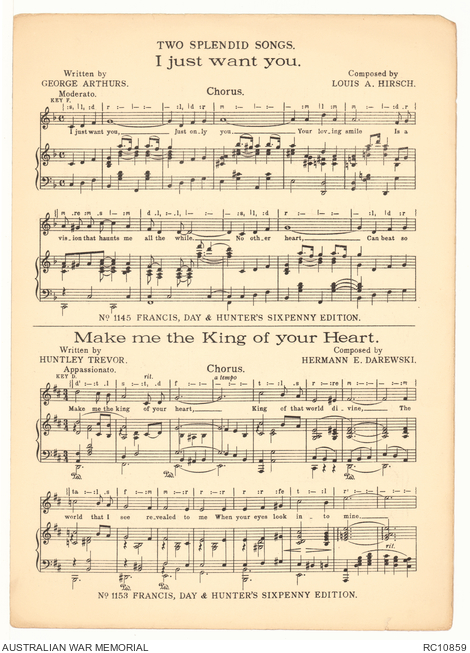| Accession Number | RC10859 |
|---|---|
| Collection number | Sheet Music Collection 374 |
| Collection type | Published Collection |
| Record type | Item |
| Item count | 1 |
| Measurement | Overall: 36 cm x 26 cm |
| Object type | Sheet Music |
| Maker |
David, Worton Lee, Bert |
| Place made | United Kingdom |
| Date made | 1914 |
| Conflict |
First World War, 1914-1918 |
| Copying Provisions | Copyright restrictions apply. Only personal, non-commercial, research and study use permitted. Permission of copyright holder required for any commercial use and/or reproduction. |
[Sheet music] I didn't want to do it, but I did







Sheet music for the song titled, 'I didn’t want to do it, but I did', written and composed by Worton David and Bert Lee. The lyrics of the song describe a romantic encounter between two characters, a male protagonist and a maid named ‘Miss Brown’.
This copy of the music was published by Francis, Day & Hunter in 1914, and performed by Jack Pleasants. The inside front cover includes advertising previews of the opening bars for the songs 'I just want you', with lyrics written by George Arthurs and music composed by Louis A. Hirsch, and 'Make me the King of your Heart', with lyrics written by Huntley Trevor and music composed by Hermann E. Darewski. The inside back cover features advertising previews of music for the two songs, 'That was the end of my dream (I never knew what parting meant)', with lyrics written and composed by Worton David and Arthur Stroud, and 'Last night was the end of the world', with lyrics written by Andrew B. Sterling and music composed by Harry von Tilzer.
This copy of the sheet music originally belonged to Private Ernest Alfred Nicholls and features his name at the top of the front cover. It is part of a collection of sheet music that was donated to the Memorial in 1971, and is symbolic of the concerts, theatre and other musical performances that Australian soldiers took in whilst on leave in London during the First World War.
Bert Lee was an English songwriter who contributed many music hall hits. He collaborated with Robert Patrick Weston in the art of songwriting between 1915 until 1935 after meeting at the offices of Francis Day & Hunter. Robert Harris Weston, the son of Robert Patrick Weston, subsequently collaborated with the duo in the production of 'Harmonica Dan' in 1936. The Weston and Lee duo also went on to work with Stanley Holloway and Gracie Fields. One of their earliest songs was 'Paddy McGinty's Goat', while later works included several popular wartime songs such as the tongue twister 'Sister Susie's Sewing Shirts for Soldiers', the tribute to farewells 'Good-Bye-Ee' and the original song 'Hush here comes the dream man', that was later reworked by soldiers into the parody 'Hush here comes a whizzbang'.
Ernest Worton David, commonly known as Worton David, produced his first hit song at the age of 17. Around this time he started working in a solicitor’s office but dedicated his spare time to writing stories, and subsequently joined The Leeds Mercury. As his talents extended to illustrations, his job also involved attending the Leeds Empire Theatre to draw cartoons of the entertainers. After selling a few of his songs to the entertainers he moved to London with his wife and son. He collaborated with many other artists and produced songs for several music hall stars in London including Marie Lloyd and Florrie Ford. One of these collaborations involved the publisher, Lawrence Wright, who is reported to have described Worton David as the best writer of lyrics in Britain. Together they produced ‘Are we downhearted? – No!’ and the very popular ‘That old-fashioned mother of mine’. When the partnership ended, David started his own music publishing business.
Towards the bottom of this page is a sound recording of this sheet music, or a parody, that was created as part of the Music and the First World War project. More information about this recording, including names of the performers, can be found on the catalogue record for the sound recording. A link to the catalogue record for the sound recording can be found at the bottom of this page, under the heading ‘Related objects’ where it can be identified with the prefix [sound recording].
- Download PDF document of [Sheet music] I didn't want to do it, but I did (file)
-
Listen to
[Sheet music] I didn't want to do it, but I did